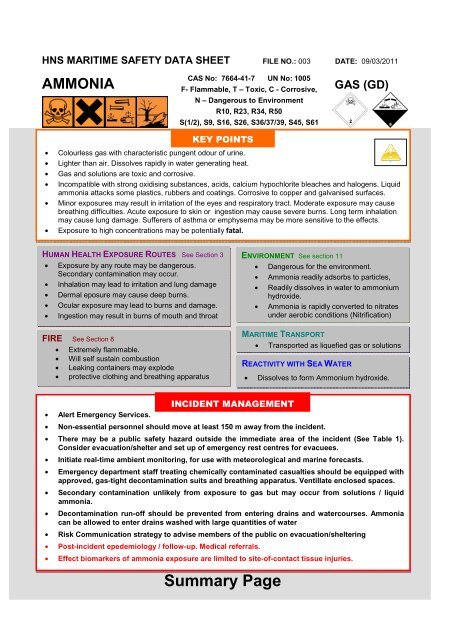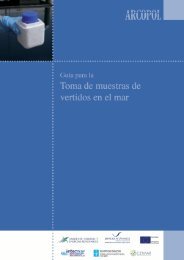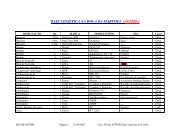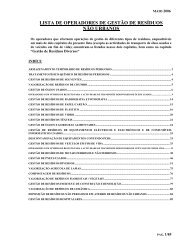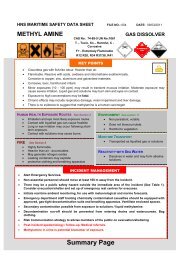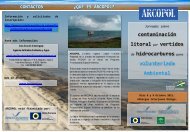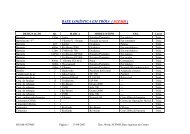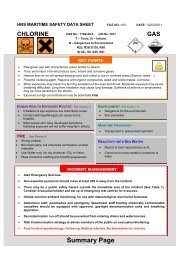ammonia gas (d) - Arcopol.eu
ammonia gas (d) - Arcopol.eu
ammonia gas (d) - Arcopol.eu
Create successful ePaper yourself
Turn your PDF publications into a flip-book with our unique Google optimized e-Paper software.
HNS MARITIME SAFETY DATA SHEET FILE NO.: 001 DATE: 15/05/2010AMMONIAHUMAN HEALTH CONSIDERATIONS – See Section 3 to 6ERG 2008 Table 1: Initial isolation and protective action distancesGAS (GD)Chemical Name Spill Size DefinitionIsolation Zone in DownWind Protection Zoneall directions Day NightSmallFrom small package or smallleak form large package30m (100ft) 0.1 km (0.1mi) 0.2 km (0.1mi)AmmoniaLargeFrom a large package or2.3 km150m (500ft) 0.8 km (0.5mi)from many small packages(1.4 mi)FireIf substance involved in fire 1600 meters (1 consider evacuation for thatmile)distance in all directionsIsolation Distance: All personnel to be directed in a cross wind direction this distance from the spillProtective Action Zone: A square area down wind of the spill where protective action should be considered, starting with nearest receptors andworking away from spill.Such estimates should always be regarded with reservations and never be alternatives for monitoring.Acute Health Hazardsppm mg m -3 Signs and symptoms50 35 Slight irritation to eyes, nose and throat100 70 Rapid irritation to eye and respiratory tract700 488 Immediately irritating to eyes and throat1500 1045 Pulmonary oedema and coughing2500 1742 Life threateningMonitoring Strategy (Short & Long Term) & Equipment – See Section 6Health and SafetyEnvironmentalPublic HealthAir - Real-time electrochemical or photionisation detection or using quantitative colour change tubes(Draeger or similar). Water - Quantitative colour change kits or probes (Palintest or similar).Atmospheric fate and transport e.g. Aloha (immediate risk / first response), Calpuff (longer term)GP referrals, hospital admissions – numbers, symptomology, follow-up studies. (See Biomarkers)OPERATIONAL EMERGENCY RESPONSE – See Section 8 & 9Fire fightingmeasures:Decontamination ofrespondersResponse &Clean up:Waste ManagementUse fine spry to control mitigation of vapours. Use CO 2 or dry chemical extinguishers for small fires,water spray or foam for large fires. Tanks may explode when exposed to high temperturesDecontamination should be performed using local protocols in designated areas with adequateventilation. Water should be contained and disposed of at an appropriate waste facility.Protect sensitive water courses. Ammonia can enter drains when washed with water. Solutions may becontained and recovered.Ventilate confined spaces. Ammonia will not persist in the environment.Dispose as hazardous waste. N<strong>eu</strong>tralise strong solutions with dilute acid if necessary. Washcontaminanted clothing thoroughly before re-use.EMERGENCY CONTACTSORGANISATIONTELEPHONEFIRE, AMBULANCE, POLICE 999HEALTH PROTECTION AGENCY: Chemical Hazards Unit 08448 920555ENVIRONMENT AGENCY: 24/7 Pollution 0800 807060PAGE 2 OF 11Summary Page
HNS MARITIME SAFETY DATA SHEET FILE NO.: 003 DATE: 09/03/2011AMMONIASECTION 1: IDENTIFICATIONCAS No: 7664-41-7 UN No: 1005F- Flammable, T – Toxic, C - Corrosive,N – Dangerous to EnvironmentR10, R23, R34, R50S(1/2), S9, S16, S26, S36/37/39, S45, S61GAS (D)NAME: Ammonia CHEMICAL FORMULA: NH 3SYNONYMS: anhydrous <strong>ammonia</strong>CAS No: 7664-41-7 UN No: 1005 EINECS : 231-635-3CLASSIFICATIONSF – Flammable, T – Toxic, C – Corrosive, N – Dangerous to EnvironmentRISK PHRASESSAFETY PHRASESR10 FlammableR23 Toxic by inhalationR34 Causes burnsR50 Very toxic to aquatic organismsS(1/2) Danger of serious damage to health by prolonged exposure through inhalationS9 Keep container in a well ventilated placeS16 Keep away from sources of ignition No SmokingS36/37/39 Wear suitable protective clothing, gloves and eye/face protectionS45 In case of accident or if you feel unwell seek medical advice immediately.S61 Avoid release to the environment.USES:Ammonia is produced industrially by reacting hydrogen and nitrogen at high temperature and pressure. Thisreaction is known as the Haber-Bosch process.Uses for <strong>ammonia</strong> include production of fertilisers, plastics,synthetic fibres, dyes, explosives and pharmac<strong>eu</strong>ticals.Trade statistics 2007 for <strong>ammonia</strong> indicate annual UK import and export in the order of 400,000 tonnes. Ammoniais typically transported as liquefied <strong>gas</strong> or aqueous solution.SECTION 2: PHYSICAL CHEMICAL PROPERTIESSEBC CLASSIFICATION G D GAS DISSOLVER BOILING POINT -33 deg CAPPEARANCE Colourless <strong>gas</strong> VAPOUR PRESSURE 860 kPa at 20 °CODOUR Urine SPECIFIC GRAVITY(air = 1): 0.8 at 21 °CFLAMMABILITYNon-flammable, but mixtureswith air may explode whenignitedSOLUBILITY IN WATER 38% at 15 °CSTABILITY &REACTIVITYStable. Incompatible with strong oxidising substances, acids, calcium hypochloritebleaches and halogens. Liquid <strong>ammonia</strong> attacks some plastics, rubbers andcoatings. Corrosive to copper and galvanised surfaces.Emits toxic fumes of <strong>ammonia</strong> and oxides of nitrogen when heated to decompositionPAGE 3 OF 11
HNS MARITIME SAFETY DATA SHEET FILE NO.: 003 DATE: 09/03/2011AMMONIASECTION 3: HUMAN HEALTH HAZARDSCAS No: 7664-41-7 UN No: 1005F- Flammable, T – Toxic, C - Corrosive,N – Dangerous to EnvironmentR10, R23, R34, R50S(1/2), S9, S16, S26, S36/37/39, S45, S61GAS (D)Following exposure to any chemical, the adverse health effects you may encounter depend on several factors,including the amount to which you are exposed (dose), the way you are exposed, the duration of exposure, theform of the chemical and if you were exposed to any other chemicals.ROUTES OF ENTRY: Exposure by any route may be dangerous. Inhalation and ocular exposure are mostlikely due to its <strong>gas</strong>eous nature.POTENTIAL HEALTH EFFECTSINHALATIONEYESSKININGESTIONInhalation may result in irritation of eyes and nose with sore throat, cough, chest tightness,headache, ataxia and confusion. Dyspnoea and stridor due to laryngeal oedema my follow.Ocular exposure contact may result in pain, blepharospasm, lacrimation, conjunctivitis,palpebral oedema, photophobia and corneal burns which should be considered anophthalmic emergency.Dermal exposure may result in deep, full thickness, liquefaction burns due to thesolubilisation of proteins and collagen, saponification of lipids and the dehydration of tissuecells leading to extensive damage.Ingestion may cause immediate burning of the mouth and throat, drooling, difficultyswallowing with retrosternal and abdominal pain. There is often hypersalivation andvomiting. Haematemesis and shock may complicate severe cases. The larynx may also beburned causing oedema, airway obstruction and difficulty clearing bronchial secretions.Strong alkalis such as <strong>ammonia</strong> may damage the oesophagus more than the stomach withulceration, perforation and mediastinitis.There is no evidence to suggest that <strong>ammonia</strong> can affect the health of the unborn child.ACUTE HEALTH HAZARDS: Ammonia <strong>gas</strong> and mists of solution are severe respiratory tract irritants.Concentrated solutions or vapours may cause severe, penetrating dermal burns or necrosis. Ammonia maycause eye irritation, lacrimation and conjunctivitis and has been reported to cause temporary or permanentblindness. Ingestion may cause epi<strong>gas</strong>tric pain, nausea and vomiting, swelling of the lips, mouth and larynx.ppm mg m -3 Signs and symptoms50 35 Slight irritation to eyes, nose and throat100 70 Rapid irritation to eye and respiratory tract700 488 Immediately irritating to eyes and throat1500 1045 Pulmonary oedema and coughing2500 1742 Life threateningCHRONIC HEALTH HAZARDS: Prolonged low concentrations of <strong>ammonia</strong> may lead to chronic bronchitis,pulmonary fibrosis and chemical pn<strong>eu</strong>monitis.CARCINOGENICITY: Non Carcinogen. No reported reproductive or teratogenic effects.PAGE 4 OF 11
HNS MARITIME SAFETY DATA SHEET FILE NO.: 003 DATE: 09/03/2011AMMONIACAS No: 7664-41-7 UN No: 1005F- Flammable, T – Toxic, C - Corrosive,N – Dangerous to EnvironmentR10, R23, R34, R50S(1/2), S9, S16, S26, S36/37/39, S45, S61SECTION 4: EXPOSURE GUIDELINES AND STANDARDSODOUR THRESHOLD: 5 – 50 ppm (3.5 - 35 mgm -3 )TASTE THRESHOLD:1.5 ppm in waterGAS (D)EU AIR QUALITY GUIDELINE:No guideline value specified(UK EAL – short term 2.5 mgm -3 , long term 0.18 mgm -3 )DRINKING WATER QUALITY GUIDELINE 0.5 mg L -1(UK DWI 2000)WORKPLACE EXPOSURE LIMITS(UK Health and Safety Executive)25 ppm (18 mg m -3 ) (8 hour reference period)35 ppm (25 mg m -3 ) (15 min reference period)EMERGENCY RESPONSE PLANNING GUIDELINE (ERPG) VALUES(American Industrial Hygiene Association)Listed value (ppm) Calculated value (mg m -3 )ERPG-1* 25 18ERPG-2* 150 105ERPG-3* 750 525* Maximum airborne concentration below which it is believed that nearly all individuals could be exposed for up to 1 hr withoutexperiencing other than mild transient adverse health effects or perceiving objectionable odour.** Maximum airborne concentration below which it is believed that nearly all individuals could beexposed for up to 1 hr without experiencing or developing irreversible or other serious health effects orsymptoms which could impair an individual's ability to take protective action.*** Maximum airborne concentration below which it is believed that nearly all individuals could beexposed for up to 1 hr without experiencing or developing life-threatening health effects.ACUTE EXPOSURE GUIDELINE LEVELS (AEGLs) (U.S. Environmental Protection Agency)ppm10 min 30 min 60 min 4 hr 8 hrAEGL-1† 30 30 30 30 30AEGL-2†† 220 220 160 110 110AEGL-3††† 2700 1600 1100 550 390† The level of the chemical in air at or above which the general population could experience notable discomfort.†† The level of the chemical in air at or above which there may be irreversible or other serious longlastingeffects or impaired ability to escape.††† The level of the chemical in air at or above which the general population could experience lifethreateninghealth effects or death.PAGE 5 OF 11
HNS MARITIME SAFETY DATA SHEET FILE NO.: 003 DATE: 09/03/2011AMMONIACAS No: 7664-41-7 UN No: 1005F- Flammable, T – Toxic, C - Corrosive,N – Dangerous to EnvironmentR10, R23, R34, R50S(1/2), S9, S16, S26, S36/37/39, S45, S61SECTION 5: EXPOSURE CONTROLS / PERSONAL PROTECTIONCONTROLS:- Use fine water spray.GAS (D)- Spillages and decontamination run-off should be prevented from entering sensitive watercourses. Ammonia canbe allowed to enter drains washed with with large quantities of water.PERSONAL PROTECTIVE EQUIPMENTNOTE:Where atmospheric <strong>ammonia</strong> concentrations are unknown or exceed 250 ppm recommend fullencapsulation (<strong>gas</strong>-tight) clothing and SCBA or positive pressure air supply respirator.EMERGENCY ACTION CODEEAC 2RERESPIRATORY PROTECTION Breathing apparatus (BS EN 137)EYE PROTECTIONChemical resistant goggles (BS EN166)SKIN PROTECTION Liquid-tight chemical protective clothing (BS 8428)EMERGENCY RESPONDERSOTHER PROTECTIVE CLOTHINGOR EQUIPMENTAmbulance staff, paramedics and emergency department staff treatingchemically contaminated casualties should be equipped with approved,<strong>gas</strong>-tight decontamination suits based on EN466:1995, EN12941:1998 andprEN943-1:2001, where appropriate with breathing apparatus(BS EN 137).APP A(c) Liquefied <strong>gas</strong> with boiling point below -20 °C.WORK HYGIENIC PRACTICES:Decontamination should be performed using local protocols in designated areas such as a decontaminationcubicle with adequate ventilation.Secondary contamination is possible. Ammonia is highly soluble and can condense on the skin and contaminateothers dermally and by volatilisation, unless protected. Wash skin with soapy water for 10 – 15 minutes.DECONTAMINATION OF RESPONDERS:Decontamination should be performed using local protocols in designated areas such as a decontaminationcubicle with adequate ventilation. Wash skin with water for 10 – 15 minutes.NON ESSENTIAL PERSONNEL / PUBLICThere may be a public safety hazard outside the immediate area of the incident. People should stay indoors withwindows and doors closed, ignition sources should be eliminated and ventilation stopped.Non-essential personnel should move at least 150 m away from the incident.Risk communication via news media as well as internet / telephone advice lines should be initiated to inform localresidents / public based upon forecast data or Table 1 estimates.PAGE 6 OF 11
HNS MARITIME SAFETY DATA SHEET FILE NO.: 003 DATE: 09/03/2011AMMONIASECTION 6: MONITORING AND DETECTIONCAS No: 7664-41-7 UN No: 1005F- Flammable, T – Toxic, C - Corrosive,N – Dangerous to EnvironmentR10, R23, R34, R50S(1/2), S9, S16, S26, S36/37/39, S45, S61GAS (D)HEALTH AND SAFETY• Use real-time monitoring by electrochemical sensors or photoionisation detector (PID) and / or quantitativedetection tubes such as Draeger tubes.• Note PID is non compound specific so will detect other volatile contaminants in addition to <strong>ammonia</strong>.• Monitor for asphyxiant atmospheres (oxygen depletion) before entering confined spaces.Ammonia islighter than air so will accumulate less in poorly ventilated areas, voids and other confined spaces.• Use colorimetric quantitative kits or electrochemical probes for aqueous liquids.ENVIRONMENTAL HEALTH• Ammonia is highly soluble and does not persist in the environment. Dissolves in water to form ammoniumhydroxide.• Fire and explosion may lead to particulates and other contaminants including oxides of nitrogen.• Use monitoring data, marine and meteorological data to predict <strong>gas</strong> cloud / smoke plume movement usingappropriate modeling software e.g. Aloha (immediate risk / first response), CALPUFF (longer term).• In the absence of data refer to Table 1 below for potential isolation and protective distancesChemical Name Spill Size DefinitionAmmoniaSmallLargeFireFrom small package orsmall leak form largepackageFrom a large packageor from many smallpackagesIf substance involved infireIsolation Zone DownWind Protection Zonein all directions Day Night30m (100ft) 0.1 km (0.1mi) 0.2 km (0.1mi)150m (500ft)1600 meters (1mile)0.8 km (0.5mi)2.3 km(1.4 mi)consider evacuation for thatdistance in all directionsIsolation Distance: All personnel to be directed in a cross wind direction this distance from the spillProtective Action Zone: A square area down wind of the spill where protective action should be considered, starting withnearest receptors and working away from spill.Such estimates should always be regarded with reservations and never be alternatives for monitoring.These estimates can also be applied to liquid chemicals which are flammable and/or hazardous for health.PUBLIC HEALTH FOLLOW-UP EPIDEMIOLOGY &• Collate GP referrals, hospital admissions – numbers, symptomology, age, sex, pre-existing conditions• Effect biomarkers of <strong>ammonia</strong> exposure are limited to site-of-contact tissue injuries (ATSDR)• Follow-up studies where public health may have been impacted (see chronic effects Section 3)SECTION 7: FIRST AID MEASURESPAGE 7 OF 11
HNS MARITIME SAFETY DATA SHEET FILE NO.: 003 DATE: 09/03/2011AMMONIACAS No: 7664-41-7 UN No: 1005F- Flammable, T – Toxic, C - Corrosive,N – Dangerous to EnvironmentR10, R23, R34, R50S(1/2), S9, S16, S26, S36/37/39, S45, S61GAS (D)Important Notes• Ambulance staff, paramedics and emergency department staff treating chemicallycontaminated casualtiesshould be equipped with Department of Health approved, <strong>gas</strong>-tight (Respirex) decontamination suitsbased on EN466:1995, EN12941:1998 and prEN943-1:2001, where appropriate.• Decontamination should be performed using local protocols in designated areas such as adecontamination cubicle with adequate ventilation.• Secondary contamination may occur.Dermal exposure• Remove patient from exposure.• The patient should remove all clothing and personal effects.• Double-bag soiled clothing and place in a sealed container clearly labelled as a biohazard.• Wash hair and all contaminated skin with copious amounts of water (preferably warm) and soap for atleast 10-15 minutes.• Decontaminate open wounds first and avoid contamination of unexposed skin.• Pay special attention to skin folds, axillae, ears, fingernails, genital areas and feet.• Burns totalling more than 15 % of body surface in adults (>10 % in children) will require standard fluidresuscitation as for thermal burns.• Cover affected area with a clean non-adherent dressing.Ocular exposure• Remove patient from exposure.• Remove contact lenses if necessary and immediately irrigate the affected eye thoroughly with water or0.9% saline for at least 10-15 minutes.• Patients with corneal damage or those whose symptoms do not resolve rapidly should be referred forurgent ophthalmological assessment.Inhalation• Remove patient from exposure. Ensure a clear airway and adequate ventilation.• Give oxygen to patients with respiratory symptoms.• Apply other supportive measures as indicated by the patient’s clinical condition.Ingestion• Ensure a clear airway and adequate ventilation.• Give oxygen to symptomatic patients.• Do not attempt <strong>gas</strong>tric lavage or give n<strong>eu</strong>tralising chemicals as heat produced during n<strong>eu</strong>tralizationreactions may increase injury.• Apply other measures as indicated by the patient’s clinical condition.PAGE 8 OF 11
HNS MARITIME SAFETY DATA SHEET FILE NO.: 003 DATE: 09/03/2011AMMONIASECTION 8: FIRE FIGHTING MEASURESCAS No: 7664-41-7 UN No: 1005F- Flammable, T – Toxic, C - Corrosive,N – Dangerous to EnvironmentR10, R23, R34, R50S(1/2), S9, S16, S26, S36/37/39, S45, S61GAS (D)Incompatible with strong oxidising substances, acids, calcium hypochlorite bleaches and halogens. Liquid<strong>ammonia</strong> attacks some plastics, rubbers and coatings. Corrosive to copper and galvanised surfaces.FLAMMABILITY:Non flammable, but mixtures of <strong>ammonia</strong> and air may explode when ignitedLOWER EXPLOSIVE LIMIT: 15%UPPER EXPLOSIVE LIMIT: 28%EXTINGUISHING MEDIA:Small fire – Dry chemical or CO2 extinguisher. Large fires - water spray or foam.SPECIAL FIRE FIGHTING PROCEDURES:Spillages and decontamination run-off may be washed to drainswith large quantities of water.HAZARDOUS DECOMPOSITION PRODUCTS: Reacts with water to form ammonium hydroxide and heat.Emits toxic fumes of <strong>ammonia</strong> and oxides of nitrogen whenheated to decompositionSECTION 9: RECOVERY RESPONSE AND CLEAN-UPSpecial precautions: Incompatible with strong oxidising substances, acids, calcium hypochloritebleaches and halogens. Liquid <strong>ammonia</strong> attacks some plastics, rubbers and coatings. Corrosive tocopper and galvanised surfaces.INCIDENT MANAGEMENT& RESPONSE• Use fine water spray to control migration of vapors.• Decontamination run-off can be allowed to enter drains with large quantities of water (discuss with localregulators).• Avoid run-off entering sensitive water-courses.• There may be a public safety hazard outside the immediate area of the incident. People should stayindoors with windows and doors closed, ignition sources should be eliminated and ventilation stopped.• Non-essential personnel should move at least 250 m away from the incident.CLEAN-UP/RECOVERY• Aqueous solutions may be able to be contained and collected for <strong>ammonia</strong> recovery.• Ammonia is volatile and highly soluble in water. It will not persist in the environment or bioaccumulate.• Dissolves in water to form ammonium hydroxide.PAGE 9 OF 11
HNS MARITIME SAFETY DATA SHEET FILE NO.: 003 DATE: 09/03/2011AMMONIACAS No: 7664-41-7 UN No: 1005F- Flammable, T – Toxic, C - Corrosive,N – Dangerous to EnvironmentR10, R23, R34, R50S(1/2), S9, S16, S26, S36/37/39, S45, S61GAS (D)SECTION 10: WASTE DISPOSALWASTE CATALOGUE CLASSIFICATION : 28-05-08 inorganic chemicals, <strong>gas</strong>esWASTE DISPOSAL METHODENVIRONMENTALPATIENT CLOTHINGAmmonia is volatile and non persistentDissolves in water to form ammonium hydroxide. N<strong>eu</strong>tralise with weak acid.Ammonia is volatile and non persistentDissolves in water to form ammonium hydroxide. N<strong>eu</strong>tralise with weak acid.Double-bag soiled clothing and place in a sealed container clearly labelled as abiohazard. Wash soiled clothing thoroughly if not to be disposed as waste.Handling & Storage: Ammonia is typically stored as a liquified <strong>gas</strong> under pressure or in refrigerated low pressuretanks, or as an aqueous solution. Store in a cool, well-labelled, well-ventilated, fire-proof area, preferably awayfrom all sources of ignition and heat as well as incompatible materials. Store below 50 o C. Outdoor tanks should bepainted in non-reflective paint to reduce temperature effects. Refrigerated <strong>ammonia</strong> should be warmed prior totransfer. Transfer lines should be purged of air when used for <strong>gas</strong>eous <strong>ammonia</strong>. (OSHA)Transport Information: IMDG Class 2.3. Packing Instruction P200, EmS FD,SU.ADR / RID Regulations Class 2 Classification Code 2TC. IATA Class 2.3.SECTION 11: ECOLOGICAL INFORMATIONToxicity Data: Ammonia exists naturally in the environment produced from decay of organic matter. Ammonia<strong>gas</strong> will be removed from the atmosphere by rain wash-out and reaction with sulphate ions.Significant quantities released into the water can have severe short-term effects as <strong>ammonia</strong> is highly toxic to fish.In water <strong>ammonia</strong> is very soluble and will be rapidly converted under aerobic conditions to less toxic nitrate ions.Acute toxicityBioassay conditions/analysed parametersSpecies Age/Size TemperatureSalinity ‰ LC50 -48h LC50 96hDaphnia magna(Water flea)(°C)- - - 24 - 180 mg/LCatfish - - - 0.28 mg/LPimephalespromela (fatheadminnow)- - - 8.2 mg/LReferenceToxnet HSDBIn soil <strong>ammonia</strong> has low mobility and will adsorb strongly to solid particles. Ammonia does not bioaccumulate.Plants have a high affinity for <strong>ammonia</strong> <strong>gas</strong> via stomata. In aerobic soil <strong>ammonia</strong> will be converted to nitrate insoils (nitrification). Nitrification and plant uptake can lead to acidification of soilsCritical exposure concentrations for protection of vegetation and ecosystems are given for <strong>ammonia</strong> as:3.3 mg m -3 (hourly),0.27 mg m -3 (Daily) and 0.023 mg m -3 (weekly)(WHO Working Group on Ecological Effects, Les Diablerets, Switzerland, 1994)PAGE 10 OF 11
HNS MARITIME SAFETY DATA SHEET FILE NO.: 003 DATE: 09/03/2011AMMONIACAS No: 7664-41-7 UN No: 1005F- Flammable, T – Toxic, C - Corrosive,N – Dangerous to EnvironmentR10, R23, R34, R50S(1/2), S9, S16, S26, S36/37/39, S45, S61GAS (D)SECTION 12: CASE STUDY – MARITIME INCIDENTRené 16, port of Landskrona, Sweden, 1976. An incorrect choice of hose produced a leak of about 180 tonnes of<strong>ammonia</strong> onto the quay. A large cloud covered the vessel and was moved by the wind towards a shipyard nearby.The cloud dispersed after about an hour. Two members of the crew were found dead on the quay. No informationon public health impact.SECTION 13: CASE STUDY – REPORTED PUBLIC HEALTH EFFECTSNo reported studies for maritime incidents.Toulouse, 2001. An explosion at a fertiliser factory resulted in 30 fatalities and several thousand casualties. Localpopulations complained of eye and respiratory symptoms and reported strong odours of <strong>ammonia</strong>. Follow upstudies identified increased incidence of acute coronary syndromes and psychological disorders in exposedpopulations.SECTION 14: SOURCES OF FURTHER INFORMATIONUK Health ProtectionAgencyEmergency ResponseGuidebookTOXNET HazardousSubstances DatabaseTransport DataCAMEOALOHACEDREARCOPOLEMSAhttp://www.hpa.org.uk/Topics/ChemicalsAndPoisons/CompendiumOfChemicalHazards/ne/http://wwwapps.tc.gc.ca/saf-sec-sur/3/erg-gmu/erg/ergmenu.aspxhttp://toxnet.nlm.nih.gov/http://encyclopedia.airliquide.com/Encyclopedia.asp?GasID=2#MSDShttp://cameochemicals.noaa.gov/http://www.epa.gov/osweroe1/content/cameo/aloha.htmhttp://www.cedre.fr/index-en.phphttp://www.arcopol.<strong>eu</strong>/home.aspxhttp://www.emsa.<strong>eu</strong>ropa.<strong>eu</strong>/PAGE 11 OF 11


